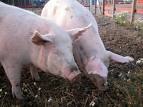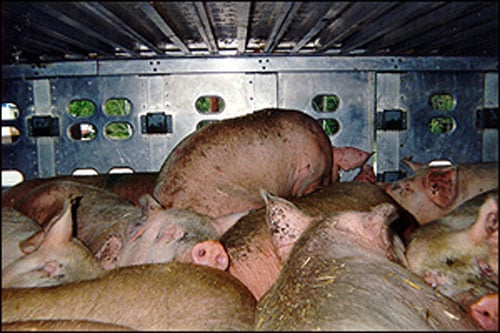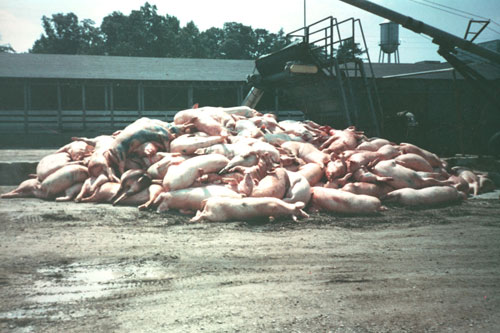The A H1N1 Pandemic: Pig to Human Transmission of the Swine Flu?

The initial outbreak of the H1N1 swine virus is said to have occurred in Mexico. The emphasis, at the political level, has been on tracking the spread of the Mexican swine flu virus as well controlling and monitoring the movement of people in and out of Mexico. A global campaign of fear and insecurity was unleashed following the WHO April 28 announcement of a phase 5 pandemic. The decision of the WHO, which was taken after consultations with Washington and Brussels, was based on unconfirmed and incomplete data regarding the spread of the swine flu and the numbers of cases.
What proves that Mexico was the epicentre of the WHO’s global swine flu pandemic?
There are several important issues underlying this question:
1. The official data pertaining to morbidity and mortality were, in numerous cases, both in Mexico, the US and around the World, not firmly corroborated by laboratory testing of the H1N1 virus.
A large number of so-called recorded cases were the result of data manipulation. The Mexican data used by the WHO to justify the phase 5 pandemic, largely pertained to cases of non-specific rather than laboratory confirmed H1N1 influenza. Out of the 159 deaths reported prior to the WHO’s decision on April 28th, only 7, according to official sources, had been corroborated by laboratory tests of H1N1 infection.
Another case in point, which directly implicates the Atlanta based Centers for Disease Control and Prevention (CDCP), was an April 30 report by the CDCP entitled Swine-Origin Influenza A (H1N1) Virus Infections in a School — New York City. The report outlines swine flu infection among New York school children, when in fact the children had been infected with a non-specific influenza. None of these cases were corroborated by laboratory testing:
In the first week in May, “the CDC claimed 109 victims of confirmed swine flu in the United States. Forty five of the 109 came from this New York School. The TV news channels were flooded with panic messages of the uncontrolled spread of Swine Flu.” (see William Engdahl, Flying Pigs and the WHO, Global Research, May 2009)
The question is: can we trust the official figures and statements.
2. Numerous cases of alleged H1N1 infection in North America, the Europe Union and other countries have been reported, which bear no causal relationship to the Mexican outbreak, namely they cannot be traced back to Mexico.
Are the cases of H1N1, reported in different countries, the consequence of a process of international transmission of the swine flu virus, or are they the result of a pre-existing situation? Or are they the consequence of a process of incorrect and misleading recording of the data. In other words, were these various “recorded cases” corroborated by lab testing of the H1N1 virus?
3. According to a recent report (Bloomberg, May 12, 2009) which was barely publicised, a prominent scientist directly involved in the development of Tamiflu points to the possibility that the H1N1 strain “resulted from lab experimentation or vaccine production”. According to professor Adrian Gibbs of the Australian National University (ANU), the virus which “escaped from a lab”, was the direct product of a laboratory experiment by the company which produces Tamiflu.
““It could be a mistake” that occurred at a vaccine production facility or the virus could have jumped from a pig to another mammal or a bird before reaching humans, he said.” (Ibid)
There have been several previous unconfirmed reports on the issue. Professor John Oxford of St. Bart’s and the Royal London Hospital contends that “the 1957 H1N1 pandemic probably started when it escaped from a lab” (National Public Radio, May 4, 2009).
While the findings of Professor Gibbs require further investigation, they, nonetheless, raise the broader issue of transmission out of a laboratory, not to mention the underlying geographic location of a laboratory. The WHO is investigating the findings of Professor Gibbs.
4. The issue of pig to human transmission of the virus has been carefully overlooked. Can pigs infect humans with swine flu? This question is fundamental in assessing the origins as well as the causes of the pandemic.
Are industrial hog farms a source of infection?
A priori, industrial hog farms are ruled out as a possible source of viral infection both by the WHO and the Atlanta based CDCP: “The World Health Organization has insisted there is no evidence that pigs are passing the virus to humans, or that eating pork products poses an infection risk.” (Canadian Press, May 2, 2009)
Ironically, while denying pig to human transmission of the swine flu, health authorities do not deny the transmission of the H1N1 from humans to pigs (see our analysis below).

Photo Copyright GoVeg.com
Pig to Human Transmission of Swine Flu
The focus of the WHO and the Atlanta based CDCP has been on human to human transmission of the swine flu virus, from one country to another, while carefully avoiding the broader issue of pig to human transmission.
The WHO has argued that in the case of the H1N1 swine flu strain (a hybrid combination of human, pig and avian flu), there is no possible transmission from pigs to humans. This assessment implies that the health and environmental conditions on the hog farms have nothing to do with the spread of the virus.
While one of the first cases of the H1N1 influenza was recorded in the municipality of Perote, State of Veracruz, which houses an extensive hog farm industry, Mexican public health officials are categorical: the environmental and health conditions in the hog farms are not the cause of the transmission.
The City of La Gloria, Perote, is a company town, which is described in some Mexican reports as the pandemic’s “ground zero”. The employer is Granjas Carroll, a joint venture between the World’s largest hog producing company Smithfield and its Mexican partner Agroindustrias Unidas de Mexico (AUM). The Smithfield project in Perote Municipality includes 16 farms and an annual output of more than one million pigs.
According to official Mexican data, there is no tangible evidence of swine flu within the Perote hog farms, namely the pigs were not infected. A number of other ailments could, however, have been triggered among the population as a result of the health and environmental conditions in the factory farms.
The broader question is whether we can actually trust the data.
Scientific Evidence of Pig to Human Transmission
A recent authoritative study by the John Hopkins School of Public Health on Industrial Farm Animal Production (IFAP) refutes the statements of the WHO. It confirms that IFAP hog farms are not only the source of contamination of surrounding groundwater but also of the spread of novel viruses including swine flu (See Pew Commission on Industrial Farm Animal Production, Pew Foundation and Bloomberg and John Hopkins School of Public Health, Putting Meat on the Table Industrial Farm Animal Production in Americas, see also Washington Post, May 9 2009).
These viruses can be transmitted from pigs to humans and then “from person to person in a community setting and well beyond.” (Ibid) The transmission can also occur in the food chain. The virus contaminates the meat which is then consumed:
“An infectious agent that originates at an IFAP facility may persist through meat processing and contaminate consumer food animal products, resulting in a serious disease outbreak far from the ifap facility” (See Putting Meat on the Table Industrial Farm Animal Production in Americas, p. 11.)
Canadian Pigs Infected by the “Mexican Flu”
While the data regarding Granjas Carroll in Perote Municipality, remains inconclusive, there is evidence, confirmed by official reports, that at least one hog farm outside Mexico was infected by the H1N1 virus.
In early May, health authorities in Canada reported on a rather unusual case whereby an entire hog farm in the province of Alberta became infected with the H1N1 swine flu. A Mexican carpenter, returning from Mexico to a hog farm in central Alberta where he was employed, allegedly infected 220 hogs out of a total of 2200.
While denying the possibility that pigs could infect humans, Canadian officials contend that the pigs were infected by the Mexican carpenter, who had returned from Mexico:
“The farm worker returned to Canada from Mexico on April 12 and had contact with the pigs two days later. About 220 pigs in the herd of 2,200 began showing signs of the flu on April 24, said the country’s top veterinary officer, Dr. Brian Evans of the Canadian Food Inspection Agency.
All of the pigs are recovering or have recovered and the farm worker has also recovered.
One other farm worker subsequently fell ill. It’s not yet known if that person caught the swine flu.
Bulletins were sent to Alberta pork producers warning them of the possible danger that swine flu could present to their herds on April 24, said Gerald Hauer, the province’s chief provincial veterinarian. But by that time, the farm worker was already back from Mexico and on the job at the 2,200-hog operation.
“He was in the barn, doing his work on April 14,” Hauer said.
The farmer notified provincial officials that an unspecified number of his animals were showing flu symptoms on April 28. The barn was quarantined later that day and remains under quarantine.” (Canadian Press, May 3, 2009)
The Alberta hog farm, which is part of an evolving saga, is central to an understanding of the origins of the pandemic, namely that pigs on IAFP farms in North America could potentially be the source of pig to human infection.
Stage One. Mexican Carpenter infects the Pigs, Owner of the Farm and Family
The official version is that the hogs were infected by a Mexican worker.
According to the first press reports, the owner of the hog farm and his family as well as the pigs were infected by the Mexican worker. These official reports pointed unequivocally to Mexico as the source of the infection on the alberta hog farm.
Stage Two: Owner and Family of Hog Farm Test Negative
It was subsequently confirmed after laboratory confirmation that the owner and family members tested negative to the H1N1 virus.
“Canada’s chief public health officer says the people who live on an Alberta pig farm where pigs were found to be infected with swine flu have tested negative for the virus.
A number of people living on the unidentified pig farm experienced flu-like symptoms after the pigs fell ill and were tested to see if they too were infected.
But Dr. David Butler-Jones says tests suggest the people were not infected with the H1N1 swine virus. (Edmonton Sun, May 5, 2009)
The official version is that the Mexican worker infected the pigs but not the people on the farm.
Stage Three: Mexican Carpenter Tests Negative
The Mexican carpenter also tested negative to the virus, which suggests that he could not be the source of a human to pig transmission:
The pigs are thought to have been infected by a worker who had been in Mexico and was ill on his return to work in mid-April. The unidentified carpenter also tested negative for the virus,… (Edmonton Sun, May 5, 2009)
Stage Five: The Official Story Sticks. The Mexican carpenter infected the Pigs
Following the release of the lab reports confirming that the Mexican carpenter tested negative to the H1N1 virus, one might have expected that the Canadian authorities would have broadened their assumptions. If the Mexican worker tests negative, what are the likely causes of the H1N1 infection on the Alberta hog farm?
Despite the visible lack of reliable evidence, the Mexican farm worker is still considered to be the source of the infection.
The official story sticks.
“Butler-Jones says, though, that there may have been “sampling issues” and blood samples from the people will be tested for antibodies to look for a definitive answer on whether they were infected. He won’t say how many people were tested or what he means by sampling issues.” (ibid)
One might reasonably ask: was the culling intended to get rid of the evidence of infection on the hog farm?
A few days, following the report, Canadian officials announced that one quarter of the herd including the infected pigs had been culled. The pigs were infected by a Mexican. Canadian health officials believe that he tested negative to the H1N1 “because he was too far along in his recovery”. They have ordered new blood tests, “looking for antibodies to the new H1N1 swine flu virus”. (Canadian Press, May 6, 2009)
Stage Six: Culling the Infected Pigs. Covering Up the Evidence?
The pigs are infected. But all the humans on the hog farm, including the Mexican carpenter, test negative.
No report has been released regarding the results of the antibody test.Culling is defined as killing animals “with undesirable characteristics”, namely getting rid of the infected hogs.
Canadian animal health officials are categorical the culling is not related to the fact that the animals are infected with the H1N1 virus:
“This doesn’t have anything to do with the flu,” Hauer told a news conference. “It has to do … with animal welfare.” The decision to cull the herd [500 heads] was to ease overcrowding, Dr. Gerald Hauer said Saturday.
“Due to the quarantine, these animals cannot be moved off the farm as they normally would. The living conditions would soon become unacceptable due to overcrowding and they (the pigs) would have been in distress,” Hauer said. (CBC, May 10,2009)

Photo Copyright GoVeg.com
Concluding Remarks
The evidence of person to person transmission across international borders remains to be firmly established. The US authorites have used the Mexican flu outbreak as a pretext to tighten up security on the US-Mexican border,
Did the pandemic originate in Mexico. The evidence is contradictory.
Many of the reported cases in Canada, the US, and around the World, cannot be traced back to the epicenter of the virus in Mexico.
These cases were discovered and reported following the Mexican outbreak. The question is whether they were “discovered” as a result of a process of laboratory examination or were recorded without adequate testing. Are these figures reliable. Are they the product of data manipulation with a view to creating an atmosphere of fear and panic.
is the H1N1 swine virus prevalent in industrial hog farms?
Visibly there was an outbreak of swine influenza in a central Alberta hog farm, confirmed by the Canadian health authorities. The pigs tested positive to the H1N1 virus, according to the official report. People on the farm tested negative.
Canadian officials have failed to address the exact causes of the swine flu on the Albertan hog farm.
It is worth noting that there was intense lobbying by the pork industry to change the name of the virus, from swine flu to A H1N1 influenza.
If the Mexican carpenter is not the source of the infection, this suggests that the H1N1 swine flu was already prevalent in the Alberta hog farm and had noting to do with the outbreak in Mexico. This in turn raises the broader issue of H1N1 swine flu infection in similar Canadian and US hog farms as well as the issue of pig-human transmission of the virus.
What happened on the Alberta hog farm, therefore, could potentially upset North America’s industrial hog production.

